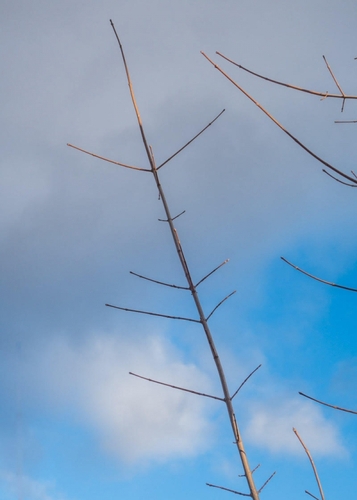BRATTLEBORO — Emerald ash borer is here. Infestation has been verified 20 miles away from Brattleboro. It is a killer; now is the time to vaccinate any ash trees you want to save, because by the time you find the pretty green insect on your tree, or notice the damage, it will be too late.
In a news release, Brattleboro Town Tree Warden Dan Adams said infested trees die from the top of the crown down, and by the time you can see from the ground that you have damage, the tree will be too far gone to save.
Ash trees are best identified by branch and bud arrangement, Adams said. Branches and buds grow directly opposite each other - they are not staggered. When looking for opposite branching in trees, consider that buds or limbs may die. Not every branch will have an opposite mate.
Adams said homeowners who have ash trees they want to save should contact a certified pesticide applicator to inject a systemic insecticide directly into the tree's trunk. Systemic chemicals are transported within the vascular system of the tree from the roots or trunk to the branches and leaves.
Insecticides applied to the soil, bark surface, or foliage are not recommended, due to their increased potential for chemical exposure. Trunk injections reduce hazards due to insecticide drift away from the site, and are less likely to impact beneficial organisms. A certified arborist database can be found at www.treesaregood.org/findanarborist/findanarborist.
The cost of pesticide application will depend on the size of the tree. An arborist certified to apply pesticides can provide an accurate estimate. Expect to pay around $190 to $285 to protect a tree with a diameter of 19 inches for two or three years' protection.
If you wait to act until the tree is dead or dying, expect to pay close to $1,000 to have a medium-size tree removed and the stump ground up. This is only an estimate. The cost of tree removal is widely variable depending on accessibility, obstacles, tree condition, and other factors.
Because of the increased risks involved with removing standing dead trees, the cost of removing an ash tree that has already succumbed to the emerald ash borer may be more than double the cost of removing a live ash tree.
It is recommended that infested wood be dealt with promptly, on-site, by burning, chipping, or burying it, as the danger of spreading the infestation is great. Infested ash firewood should not be moved.
Brattleboro's Tree Advisory Board, in conjunction with Vermont's Department of Urban and Community Forestry have located and noted ash trees on public property and within the town's right of way for the downtown and some of the urban sections of Brattleboro.
Adams said many of the more important ash trees were treated to protect them from the emerald ash borer in the spring of 2018. More public ash trees will be vaccinated this coming spring.
Meanwhile, the Vermont Urban and Community Forestry Program is partnering with the Young Writers Project to raise awareness about the emerald ash borer and its impact on Vermont forests and communities.
Youth are encouraged to submit an original work of 750 words as a persuasive essay, piece of prose or poetry that aligns with the Invasives-Challenge prompts. Submissions are due Friday, March 15. Winners will receive a cash prize and are invited to read their work at the annual Vermont Arbor Day Conference. Apply at youngwritersproject.org/node/26361.
